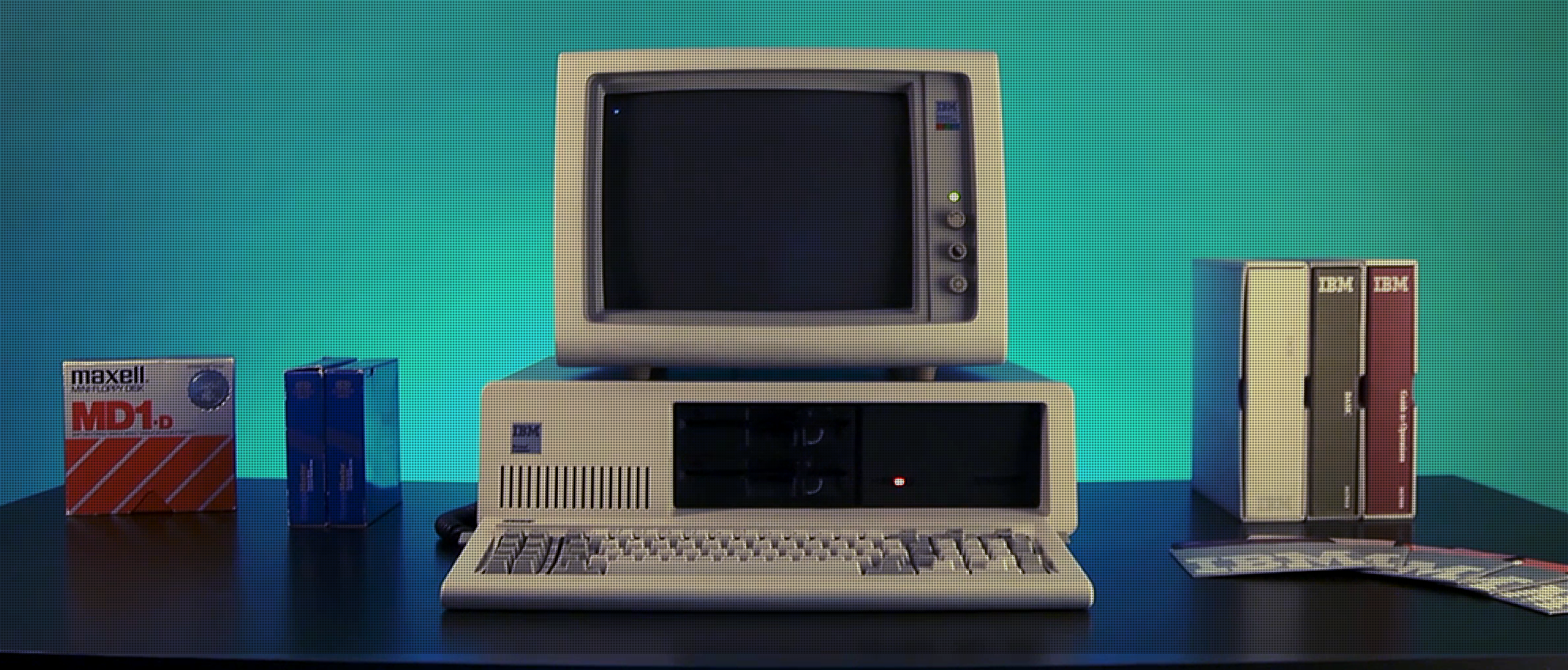1980 - 1984: x86, Rise of the 40-Year Stopgap
IBM PC Model 5150 and the Attack of the Clones
The only remarkable thing about the product that revolutionized the personal computing business was the fact that IBM built it. If any other company of the era built and marketed the IBM Personal Computer Model 5150, it might be looked back on with fondness but not as a product that changed an industry.
IBM's stature guaranteed the PC to initiate a level of standardization required for a technology to attain widespread usage. That same stature also ensured competitors would have unfettered access to the technical specifications of the Model 5150, since IBM was obligated to disclose such information under the Department of Justice 1956 consent decree, which the company operated under as an accommodation for its previous monopolistic practices.
The third facet of the Model 5150's enduring legacy came about from sourcing components via independent hardware vendors. IBM's business was built on the company designing and manufacturing nearly all of its hardware and software in house, which maximized profit at the expense of overall agility in the market as corporate in-fighting and rivalries between divisions within such a monolithic company added inertia to the decision making processes.
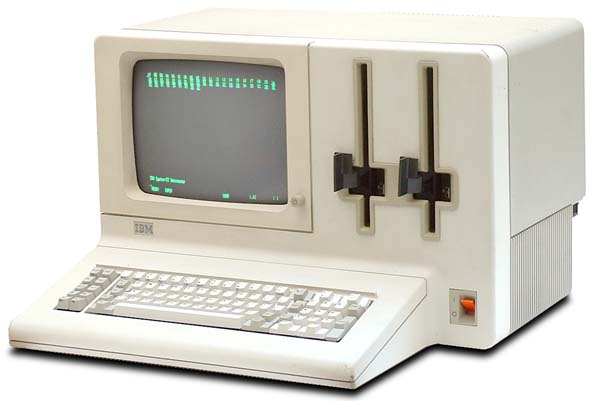
The Datamaster was an all-in-one computer with text-mode CRT display, keyboard, processor, memory, and two 8-inch floppy disk drives all contained in one cabinet. (Photo: Oldcomputers.net)
The Model 5150 wasn't IBM's first attempt at building a personal computer, with at least four previous projects being scrapped as the market moved faster than IBM's corporate decision making. The Intel 8085-equipped System/23 DataMaster business computer also enduring a protracted development starting in February 1978. The DataMaster system entry into the market in July 1981 led to the change in design strategy in addition to members of the design team being assigned work on the new PC project.
IBM's original plan had been to design the personal computer around Motorola's 6800 processor at its Austin, Texas research center. IBM marketing had arranged for the PC to be sold through the stores of Sears, Roebuck & Co., and the deal teetered in the balance as Motorola's 6800 along with its support chips slipped in schedule.
A contingency plan named Project Chess was set up to run concurrently with the Austin design and seemed to gain traction after Atari approached IBM about building a personal computer, if IBM were so inclined to design one. Official IBM sanction was achieved when project director William (Bill) Lowe pledged to have the design finalized in a year. To meet this timescale, Lowe would source from vendors outside IBM.
Project director William Lowe pledged to have the design finalized in a year sourcing components from vendors outside IBM.
What remained was choice of processor and operating system for the PC. Lowe and Estridge were astute enough to realize that IBM's senior management would not look kindly upon a PC that posed a performance threat to the company's lucrative business machines (a System/23 DataMaster terminal with printer listed for around $9,900 at the time).
The original intention seems to have been to use an 8-bit processor, which would have allowed MOS Tech's 6502, Zilog's Z80, and Intel's 8085 to be considered. However, IBM engineers favored the use of 16-bit, as did Bill Gates, who lobbied IBM to use 16-bit to fully showcase the operating system he was developing , while the arrival of 32-bit architectures from Motorola and National Semiconductor (the 68000 and 16032 respectively) were set to enter production outside of the one year deadline.
The eventual choice was a compromise of 8-bit and 16-bit to allay concerns over compatibility with existing software and expansion options while reducing the bill of materials from a cheaper processor and support chips that were already available, and to retain a significant performance gap between the PC and IBM's business machines.
IBM's decision was made easier as the microprocessor landscape was becoming a war of attrition. MOS Tech was acquired by Commodore after MOS was financially decimated by Texas Instrument's calculator price war and focus shifted from innovation to capitalizing on the success of the 6502. Western Design Center (WDC) would eventually bring 16-bit computing to the 6500 series, but as with many microprocessor companies, the competition had rendered them all redundant by the time they were ready for market.
Zilog's fortunes also suffered a downturn, as majority shareholder and later parent company Exxon was happy to see the fledgling company go into breakneck product diversification. R&D expenditure topped 35% of revenue, while the wider range of development caused slippage in its own 16-bit Z8000 processor as Exxon's demands and the relative managerial inexperience of Federico Faggin became exposed.
Faggin and Ungermann had started Zilog to build microprocessors, but Exxon had bought Zilog as a cog in a machine along with a host of other electronics and software company acquisitions for a grand design they hoped would rival IBM. This would turn into a billion dollar failure.
Zilog's waning fortunes, even as its Z80 powered a prodigious number of computers, terminals, and industrial machines, also cascaded down upon its second source licensees. AMD's license for Intel's 8085 hadn't translated into an invitation to do likewise with its follow up 8086 processor. For a viable 16-bit processor this left Jerry Sanders with the alternative of approaching Motorola or Zilog as National Semiconductors offering was shaping up as promising much but delivering little.
What remained was choice of processor and operating system for the PC, and IBM's decision was made easier as the microprocessor landscape was becoming a war of attrition.
With Motorola's delays and AMD's inability to produce its own competitive architecture, Zilog looked like the more attractive option given that as a relative newcomer it may have proved easier to work with and the Z8000 became AMD's choice. The Z8000's lack of backwards compatibility with 8-bit software doomed sales of the processor, and customers that had flocked to the Z80 quickly turned to Intel. Where Zilog had the successful Z80, and world's largest oil company covering losses, AMD had no such options.
For its part, Intel had planned for a vast leap in processor architecture as soon as the 8080 had been completed. The envisaged chip, known internally as the 8816, would have been over four times the size of the existing 8-bit chip, with 16-bit and 32-bit functionality and a host of features that typify a modern processor.
It became apparent in an April 14, 1976 assessment that the architecture would be a formidable challenge to produce, and most certainly not within the timeframe needed to combat the 16-bit chips of Motorola, Zilog, National Semiconductor, and Texas Instruments.
Intel required at least an interim design to fend off the competition and continue its growth and software group manager Terry Opdendyk accepted the challenge of designing a new processor architecture inside of 10 weeks – the estimated maximum length of time required for the chip to be completed in a year. Opdendyk chose Steve Morse, an engineer specializing in software and the author of the condemnatory 8816 review that initiated this project, marking the first time that design of an Intel chip architecture hadn't been the responsibility of hardware engineers.
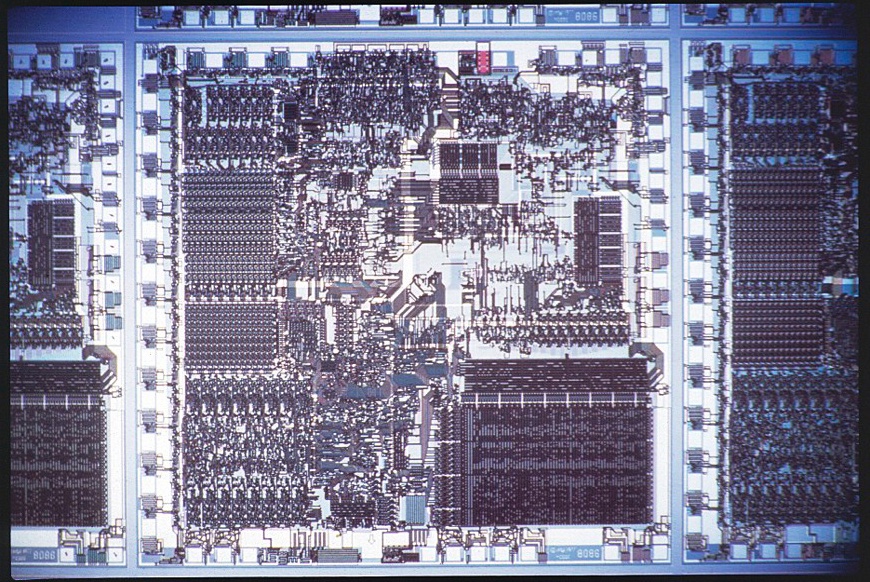
Die shot of the 16-bit Intel 8086 microprocessor. The 8086 gave rise to the famed x86 architecture which eventually turned out as Intel's most successful line of processors.
Architecture design work started in May with the two-man team of Morse and project manager Bill Pohlman, and the first revision of the architecture was duly completed in August. Two stipulations were imposed on the design: it needed backwards compatibility with the 8080 and it needed to address memory up to 128KB, double that of the 8080.
The answer to the second problem was solved by an awkward method of segmented addressing to allow 20-bit memory addresses with a chip that handled data 16 bits at a time which allowed for up to 1 megabyte of memory to be addressed. As inelegant as the resulting 8086 solution was when it arrived on June 8, 1978, it allowed Intel to beat both Motorola and Zilog in the race to a commercially viable 16-bit processor.
Intel followed up on the 8086 a year later with a cost reduced 8088 that halved the 8086's external bus from 16-bit to 8-bit targeting tighter budgets and customers seeking to extend the life of their 8080 and 8085-based systems and associated software.
While Motorola's own 16-bit processor, the 68000, wasn't launched until a full 15 months after the 8086, its design had merits over the 8086 which offset Intel's initial market lead as soon as it began sampling. Whereas Zilog was seen as a small company regardless of the amount of money being pumped into it by Exxon, Motorola was an established semiconductor company with a proven track record and high market visibility.
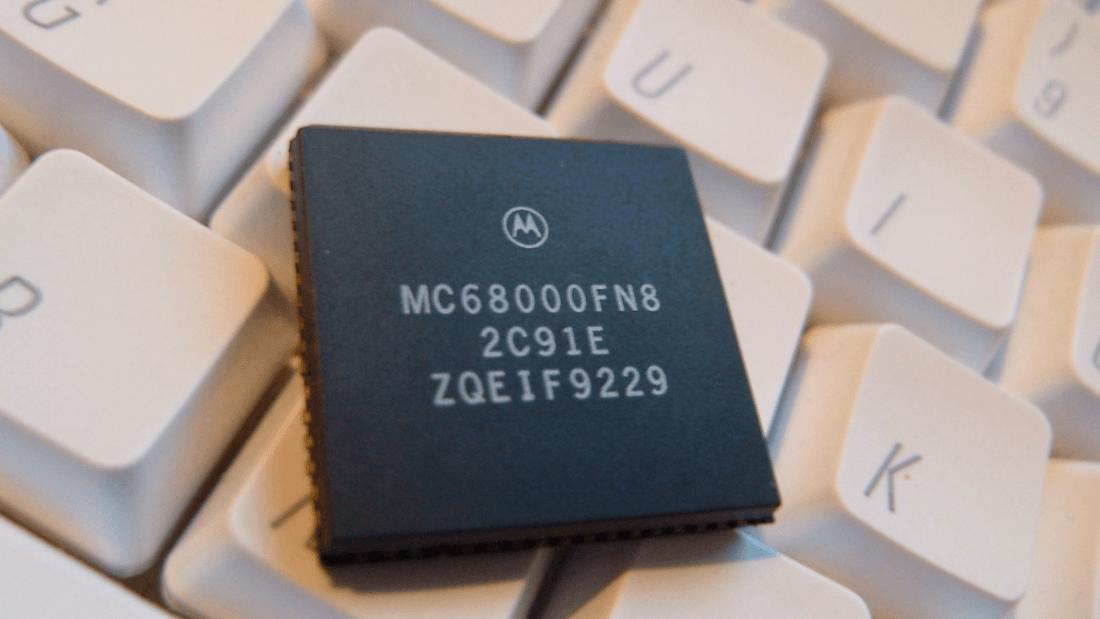
The original Apple Macintosh and early successors use the Motorola 68000 processor as their CPU.
Up to this point, Intel never really had to "sell" products to customers. Its product lines were generally superior to (or at least the equal of) the competition and demand often exceeded supply. Consequently, Intel salesmanship often amounted to a mix of complacency and arrogance, and customers relished the chance to push back against the company's attitude.
Against this backdrop, Intel instituted its first national marketing campaign spurred by an eight-page report detailing Motorola's design wins at Intel's expense from Don Buckhout, an East Coast Field Applications Engineer (FAE). The company set a goal of securing one design win per month for a year from each of its 170 sales representatives (a nominal 2000 design wins by December 1980) as part of Operation Crush, a name inspired by the Denver Bronco's "Orange Crush" 3-4 defense as well as the campaign's stated aim of crushing Motorola.
When faced with a superior processor, Intel would emphasize the system as a whole including support chips, an area where Motorola was relatively weak. Intel was processor-centric while microprocessors represented just a small part of Motorola's diverse company. Intel unashamedly played on the fear, uncertainty and doubt of customers by asking whether Motorola could sustain support, integration, and future products.
Faced with the superior 68000 processor, Intel would emphasize the system as a whole including support chips, an area where Motorola was relatively weak.
While Intel's corporate character did not ingratiate the company to those who had to deal with it, its level of technical support and products were undeniable. Intel abandoned its corporate ethos of never publicizing a product until its production was under way, allying the PR of a future product line with an extensive 100-page catalog of its chip developments.
Rather than concentrating on the 68000 where it had a marketing and technical advantage, Motorola took the bait and tried to answer Intel's yet to be built products with its own more meager alternatives. From that point, Motorola and the 68000's position of power evaporated.
Intel's goal had been to gain 2000 design wins by December 1980. Such was the success of Operation Crush that the final figure was closer to 2500, in part due to the added incentive of a prize for the most wins bought in by a salesman and their FAE. Bill Handel won with nearly 100 contracts including one for use in an electronic temperature monitoring brassiere that supposedly notified the wearer of the optimum time for conception. Handel and his FAE were each awarded 86 shares Intel stock as first prize, and along with every other sales representative who met their quota, a junket to Tahiti.
While Bill Handel might have won Operation Crush's contest, Earl Whetstone, a salesman on the opposite coast, took a chance to add to his own tally by calling IBM's Boca Raton development laboratory, despite IBM's history of designing its processors in-house. As luck would have it, IBM's Project Chess had just been initiated. Operation Crush had been set in motion to maximize the 8086's exposure, but the biggest design win of the nearly 2500 achieved was the stripped down 8088 8-bit external/16-bit internal bus hybrid chip (developed from the 8086) landing in the IBM PC Model 5150.
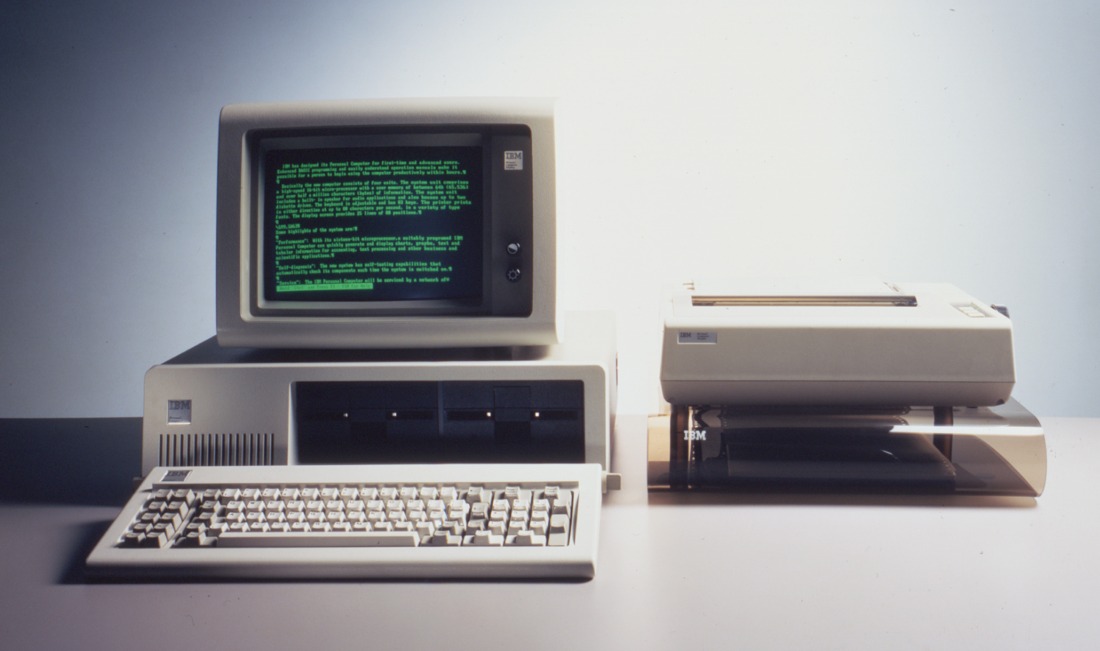
IBM Personal Computer model 5150 with IBM CGA monitor, IBM PC keyboard, IBM 5152 printer and paper stand.
Like the company's mainframe business, the IBM PC was designed for a high degree of customization. However, whereas the modularity of the mainframe came from IBM-built parts, the PC would draw on the wider opportunities afforded by independent vendors. Two separate graphics adapters were available, CGA (Color Graphics Adapter) targeting the home user and the MDA (Monochrome Display Adapter) for commercial users that included a matrix printer port. The IBM-designed mainboard offered enough expansion ports (five) for most users as well as a fairly wide range of RAM, storage, and printer options.
Intel's Operation Crush was a resounding success, but the biggest design win of the nearly 2500 achieved was the stripped down 8088 8-bit external/16-bit internal bus hybrid chip landing in the IBM PC Model 5150.
IBM's choice of operating system was to be outsourced also. The DataMaster's lengthy gestation was largely attributed to a change in design philosophy regarding the choice of BASIC interpreter for the system during its development phase and IBM had taken the lesson to heart. The exact chain of events that followed IBM's decision to use Microsoft's solution aren't entirely clear, but it began with IBM approaching Gary Kildall's Digital Research.
During the formative years of the personal computer industry, Kildall's CP/M had been the choice of operating systems for many vendors. While Kildall concentrated on the OS side of the street, Bill Gates and Paul Allen had focused on programming language variants of BASIC. An unspoken contract seemed to exist that neither company would intrude on the other's specialty.
This arrangement would sour with Digital Research Inc.'s (DRI) close association with and later acquisition of Compiler Systems, which was run by one of Kildall's graduate students, Gordon Eubanks, who had written a version of BASIC (CBASIC) for IMSAI. Shopping for an operating system, IBM arranged to meet with Kildall with a view to adapting CP/M to the 8086 and 8088 processors.
When IBM representative Jack Sams arrived at DRI to discuss the proposal, Kildall wasn't in the office and when confronted by IBM's infamous and one-sided NDA, Dorothy Kildall refused until she could seek a legal opinion. It seems probable that Kildall arrived for the meeting many hours later and too late to discuss specifics. Sams then flew to Seattle to meet with Bill Gates.
What seems certain is that Kildall's casual demeanor was at odds with Sam's (and by extension IBM's) corporate philosophy. The level of professionalism and deference that should be accorded to one of America's largest companies was distinctly lacking. Kildall's lack of urgency in accelerating what would become CP/M-86, a compatible OS for the 8086/8088, also stands out as a major stumbling block. Bill Gates however was acutely aware of IBM's stature and was quite willing to accede to IBM's demands if it meant building his business.
The only real problem Bill Gates had was that he didn't have an operating system to sell to IBM – but knew of someone who did. Gates approached Seattle Computer Products whose SCP-200B development kit utilized the 8086. While SCP sold the kits, it had been faced with the same lack of operating system as other 8086 vendors. The solution became to design its own – design being a fairly loose term, as SCP's Tim Paterson borrowed heavily from the existing CP/M by scrupulously copying the OS's API calls (which the OS uses to interact with other software).
Bill Gates was willing to accede to IBM's demands if it meant building his business. The only real problem was that he didn't have an OS to sell – but knew of someone who did.
The resultant QDOS (Quick and Dirty Operating System) debuted in July 1980, a full month before IBM went looking for the same thing from DRI and Microsoft, although it wouldn't start shipping until the end of September. SCP's loss instantly turned into Microsoft's exceedingly large gain as Bill Gates and Microsoft's first business manager Steve Ballmer pitched to IBM a license agreement for the newly found operating system, associated software, and four programming languages on a royalty basis.
Importantly, Microsoft was to remain free to license MS-DOS to other vendors.
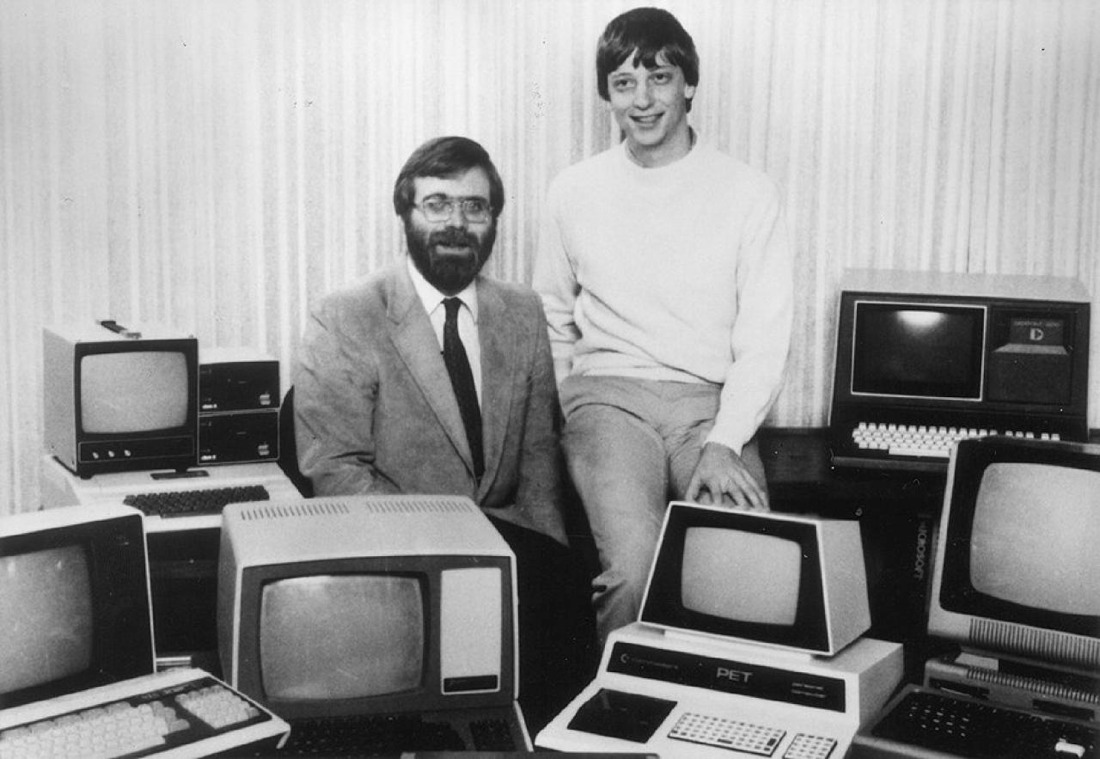
Paul Allen and Bill Gates pose next to a few early desktop systems.
IBM duly accepted and handed over a $700,000 advance a week after QDOS had been secured by Microsoft. Obtaining the operating system without alerting SCP to its empire-building promise had fallen to Paul Allen, who negotiated a per-license agreement with SCP at $10,000 per customer plus $5,000 if the source code was included and a $10,000 advance to seal the deal. The implication was that Gates and Allen had a large number of licensees locked up although a clause in the agreement stated that Microsoft's customer list was confidential – a customer list that numbered a single client.
Tim Paterson was soon added to the Microsoft workforce when 86-DOS, as it was then known, needed revision at IBM's behest. By the time the IBM PC was ready for release, Rod Brock, SCP's owner, was nearing bankruptcy as the 86-DOS licensees had failed to materialize. With his programmer long gone and lacking the funds to stay afloat, Brock accepted Gates' offer to sell 86-DOS to Microsoft for $50,000 – the equivalent of two minutes worth of sales at the height of the software's popularity a decade later as MS-DOS.
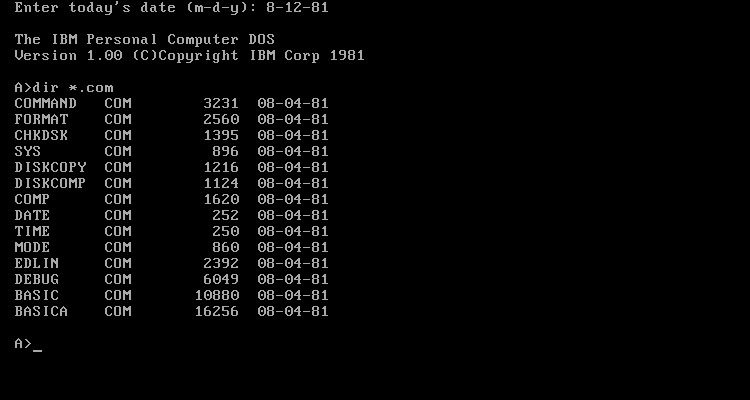
The first version of DOS had no support for hard disks, directories or loadable device drivers. (Photo: OS/2 Museum)
A major consideration for IBM was the integrity of its supply chain. With other IBM products that meant one division of the company delivering products to another. Outsourcing components was a common practice in an industry where manufacturing and yield issues were rife, so over the strong objections of Intel, IBM demanded a second source for the 8088.
Second sourcing also had the added advantage of introducing another level of quality control as processors from each company could be compared for performance and adherence to shipping schedule. IBM's preferred second source, AMD, just so happened to be looking to replace its ill-selling licensed copy of the Zilog Z8000, the AMZ8000.
With Motorola's microprocessor market share plummeting to a mere 15% as a consequence of Operation Crush, the standout candidate became fairly obvious.
Intel and AMD hammered out a deal in February 1982. Intel for its part fulfilled IBM's edict, and AMD, knowing that Intel's position was weakened due to IBM's duress, extracted a lengthy license agreement. AMD would pay royalties to Intel for three years, at which time the payments would be weighted according to value when and if Intel decided to take up options for licensing AMD products. This part of the agreement was to last for at least 5 years of the 10 provided for.
As the IBM PC neared introduction, the main talking points were of an affordable computer for the consumer, made by an iconic American company. Enthusiasts tended to note the use of BIOS, IBM's attention to system integrity with the 14-step power-on self-test (POST) sequence, and the comprehensive user manual – all taken for granted now, but groundbreaking in 1981.
No real base configuration for the IBM PC existed as set by the company, but a $1,595 price is often quoted for the machine in its unbundled form. A fully optioned version topped $6,000 with extra hardware such as dual floppy drives, memory expansion kits and additional operating systems (BASIC was included, MS-DOS added $40, CP/M-86 was $240 and UCSD p-System cost $695 – CP/M-86 being included to forestall any adverse publicity from Digital Research).
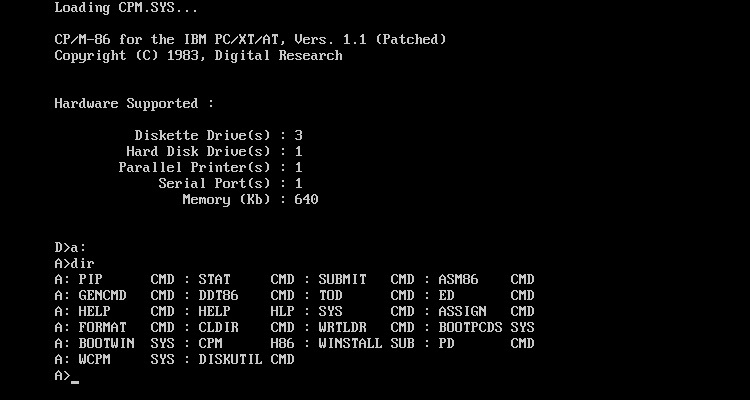
CP/M-86 was a version of the CP/M operating system from Digital Research for the Intel 8086 and Intel 8088.
For IBM PC owners desperate to run CP/M, an add-in co-processor board such as Xedex's Z80-equipped Baby Blue card could be procured. The average price of the 13,533 PCs sold by the year's end (against advance orders for over 35,000) was around $3,000. The IBM Model 5150's sales would reach 50,000 within six months, and 200,000 after a year.
The arrival of the Model 5150 did not alter the personal computing landscape at the time. The machine was too expensive for many, and like the Apple II, sales stemmed more from business users. The IBM PC became a safe option because of the reputation of the company standing behind it. The PC's effect on the industry wouldn't be felt until "IBM" became less of a selling point than "IBM Compatible".
The 13,533 PCs sold by IBM in the closing months of 1981 represented less than 1% of total sales and 1.9% of revenue for the $3 billion personal computer market, while Radio Shack and Apple accounted for a combined 37% of the sales (20% and 17% respectively). What the IBM PC would achieve was an almost instantaneous boost to the add-in board market, and a solid base for software developers.
Building on this growth, 1982 would double personal computer shipment from the previous year with 2.8 million sold worldwide. A significant part of this grown occurred with the arrival of the Commodore 64 which would redefine the budget of the PC market previously the province of the company's own VIC 20, Atari's 400 and 800, and the TRS 80, while low-end machines such as Sinclair's ZX81 intruded upon pricing until now reserved for pocket calculators.
The arrival of the Model 5150 did not alter the personal computing landscape at the time, but it became a safe option because of the company standing behind it. Its effect on the industry wouldn't be felt until "IBM" became less of a selling point than "IBM Compatible".
These lower entry level machines boosted the gaming entertainment landscape while the Commodore 64 maintained the momentum gained by the sprite-driven graphics lineage of the Atari 2600, although graphics were about to be given a serious makeover. 1982 also saw the founding of SGI, Hercules, Diamond Multimedia, Orchid Technology, Number Nine, Autodesk's AutoCAD, Electronic Arts, and On-Line became Sierra On-Line as the company grew in scope with its association with IBM as did MSA's Peachtree Accounting software, IUS's EasyWriter, ISS's WordPerfect, and the spreadsheet application synonymous with the IBM PC, Lotus 1-2-3.
The venture capital that enabled Lotus Software to begin operation originated in part from the two people that had supplied start-up funding for Silicon Graphics (SGI) and Electronics Arts. L.J.Sevin and Ben Rosen also provided half the initial capital for Compaq Computers. Formed by three disgruntled Texas Instruments engineers, and soon to be followed by many more hires from T.I., the three had seen a market for a portable version of IBM's PC.
Compaq was far from alone in quickly noticing that the PC's sales were driven more by the software available to it than the sum of the hardware in the machine, so the ideal product would be one that could use software that already existed. With IBM leading the way it was a pretty safe bet that its standard would succeed in the marketplace – by force of will if necessary. It was an added bonus being able to ally itself (however tangentially) with Big Blue by marketing its product as "IBM PC Compatible".
Companies looking to ride the coattails of a market leader were nothing new. Franklin Computer had released an exact copy of the Apple II as the Ace 100 and Apple quickly prosecuted a case against Franklin who would continue to plagiarize Apple's design until August 1983 when the U.S. Court of Appeals ruled in favor of Apple.
IBM's only protection against similar imitators would be its BIOS, and the company's false assumption that competitors could not source the components cheaper than Big Blue.
Columbia Data Product's MPC 1600 became the first IBM PC clone in June 1982, and although cheaper than the Model 5150 by around a third, the reverse engineered BIOS wasn't fully compatible with IBM hardware or the software suite. Eagle Computers, Corona and Handwell attempted the less labor-intensive option of starting with IBM's BIOS, the complete code for which IBM had included in its PC's manual, which only got IBM's formidable team of lawyers involved. Several vendors would also look to improve upon the Model 5150's feature set, notably DEC's Rainbow 100 and Seequa's Chameleon, both of which featured a Z80 in addition to the 8088, and both would fail commercially without full IBM PC compatibility.
Compaq on the other hand consulted its lawyers before starting a PC project and to protect itself used a "clean room" approach with the BIOS programmer never having seen the original IBM code. Phoenix Technologies would go on to employ the same methodology to engineer its BIOS ROM resulting in any company being able to purchase IBM compatibility off the shelf for $25 a chip and a $290,000 license fee.
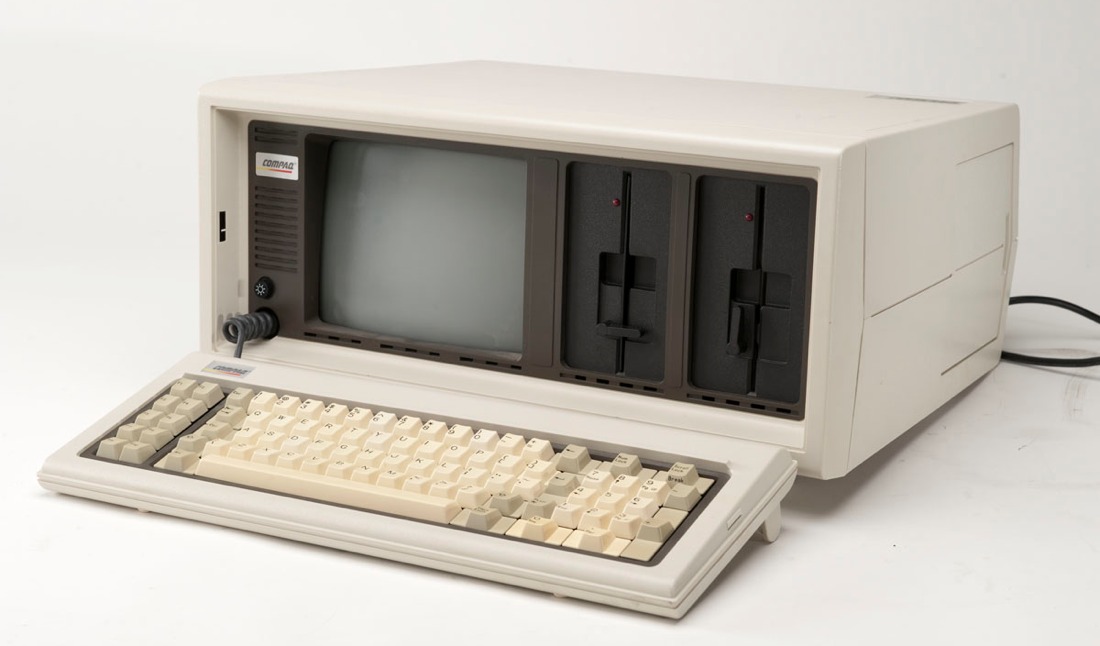
The Compaq Portable was the first 100% IBM-compatible PC, and the first portable one. (Photo: Maximum PC)
Compaq's first product was the Portable Personal Computer, publicly launched on November 4, 1982, and the first machine completely compatible on a hardware and software basis with IBM's Model 5150. The first 300 machines shipped in January 1983 with 50,000 sold by year end – part of the million 8088-based computers sold to that date. Although sales number for the year didn't indicate it (IBM sold half a million PCs during 1983 and Apple sold 750,000 which combined equaled sales of the Commodore 64), the arrival of the clones and Compaq in particular signaled the end of IBM's short-lived dominance in the market. The driving forces would from now on be companies that powered both the PC and its imitators, Intel and Microsoft.
Apple's business included neither Intel nor Microsoft and on the face of it seemed to be booming. The company shipped its one-millionth Apple II in June 1983 and continued to be a big seller until the Macintosh became the company's focus. Balanced against this was the relative flop of the Apple III, doomed by poor attention to detail during design and a robotic assembly line that failed to seat chips into circuit boards with enough pressure to ensure correct contact.
The arrival of the clones and Compaq in particular signaled the end of IBM's short-lived dominance in the market. The driving forces would from now on be companies that powered both the PC and its imitators, Intel and Microsoft.
Apple's recommendation of raising the machine a few inches then dropping it to reseat components and repeating until the machine regained its function seemed like a less than professional workaround to its users. The Lisa project, which grew out of Steve Jobs' eye opening visit to Xerox PARC in December 1979, also became a drain on resources. R&D for Jobs to recreate PARC's wonderland of networked Alto workstations topped $50 million – a thousand times the Apple II's development cost of – but at least the technology was successfully applied to later products even if the resulting Lisa was limited to around 100,000 units sold.
The principle drawback of the Apple Lisa was price. At $10,000 per machine, the target market was small and made smaller with the Lisa's lack of networking capability.
Apple rectified the cost (and customer expectation that comes from it) with the Macintosh, a project developed in tandem with Lisa, which incorporated many of the same features in a simpler design costing only a quarter of the Lisa's price tag. A Ridley Scott directed commercial using George Orwell's Nineteen Eighty-Four motif widely regarded as the pinnacle of advertisement preceded its successful launch in January 1984.
The Macintosh would continue to drive Apple's competitive market share with steady sales, although pricing and subsequent revenue fell consistently as Windows 3.0, and more importantly, associated productivity applications such as Excel and Word began to encroach into traditional Apple Mac strongholds.
Total sales of personal computers in the first four years since the Altair's introduction had amounted to 200,000 machines worldwide. A decade later, the year of 1988 would see 19 million personal computers shipped. A business that started in garages by hobbyists had turned into a multi-billion dollar industry where the camaraderie of enthusiasts had been replaced by cutthroat market competition – a competition that was about to see the patent and intellectual property wielded as economic weapons.
This article is the third installment on a series of five. If you enjoyed this, read on as get into a decade of steady growth and the consolidation of power from those that endured the industry's intense rivalries.
Bonus video
Masthead image and video above by YouTube user 41D57.
